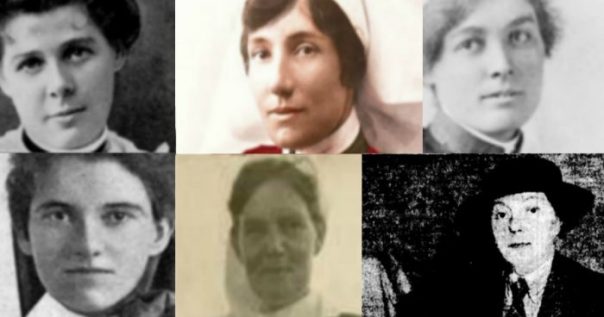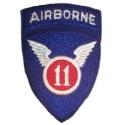Blog Archives
OKINAWA 78 years ago Stars & Stripes – Pacific
By PFC. WILLIAMS LAND | STARS AND STRIPES May 22, 1945
Stars and Stripes presents these archive reports as they were written by the reporters in the field. The graphic and politically incorrect language used may be offensive to some readers.
Editor’s Note: A fortnight ago Bill Land, one of our battlefront reporters, learned that he was a father. Back to us by radio came this story of Oki’s orphans. Unable to go home to see his own daughter in Baton Rouge, La., Bill let himself go on Oki’s orphans – being left to die by the Sons of Heaven. But the GIs wouldn’t let the kids die…
OKINAWA – Here’s a story you could call “The Children’s Hour.” Ever since I got that radio about my new baby daughter I’ve had in mind writing a children’s story, especially since the material is so plentiful.
It is said that there are more children on Okinawa than there are goats, and, brother, that is some statement.
Very rarely does one see a woman who isn’t carrying either a born or unborn child around and most of the time it’s both.
For doughboys and leathernecks, the care of children started on the first day of the invasion, and from the way it keeps on, it looks as though “the Children’s Hour on Okinawa” will outlast Lillian Hellman’s play on Broadway.
Military government has even set up an orphanage, probably the first the island has seen.
“Since the natives showed interest only their own babies, we had to do something to care for children whose parents were killed or missing,” said Army Capt. W. W. McAllister of Iowa City, Ia., the officer in charge.
Nipples are made from surgical gloves and the orphans seem to take kindly to their new diet of canned milk through a glove.
In another part of the island, Chief Pharmacist’s Mate Hugh Bell of Iberia, La., found himself playing the role of a mother when his outfit, a Marine reconnaissance unit, was scouting for suspected enemy installations and suddenly came upon a whole colony of natives hiding in a cave. Most of them were starving and sick and 35 children required immediate medical attention.
Bell, being the only “doctor in the house,” had all of them on his hands. For 24 hours he treated them, giving them plenty of food and feeding them canned milk while his buddies drank their coffee black.
“The kids thought I had used magic to fix them up,” he said, “and followed me around whenever I went. The headman of the group of cave dwellers told the unit command later that Bell was called “Mother” whenever they referred to him.
It is not at all a strange sight to see kids running around in cut-off GI woolen underwear or rompers made of fatigues, but Sally’s diapers made of green camouflage cloth really take the cake. Sally’s one of the orphans.
Sitting on the hard coral rock playing with the ration can, it looks as if she selected a soft tuft of grass to place her little behind on.
Pfc. John J. Stroke of Olmsted Falls, Ore., found her. She’s a two-year-old girl, and Stroke supervised her bath and sprinkled her with anti-vermin powder. Then, with the help of marine fatigues, a jungle knife and couple of pins, he went into the diaper business.
With most able-bodied Japs in the Imperial army or navy there seems a definite shortage of obstetricians among civilians and therefore many deliveries have to be performed by American soldiers and medics.
Relating his first attendance at childbirth here, First Class Pharmacist’s Mate Richard P. Scheid of Napoleon, O., warned, “I knock down anybody who calls me a mid-wife.”
As in the play, “The Children’s Hour,” and everywhere else, for that matter, there are good little children and naughty ones.
The other day, Sgt. Elvis Lane, marine combat correspondent from Louisville, Ky., ran across a couple of them who didn’t want to take to the American way of life at first. Dressed in a ragged Jap soldiers’ suits, they kept hoping to fight the “American devils” who were soon to be blasted by superior Japanese power.
That night, enemy units attacked the camp in which the two boys were staying and the air was filled with screams of the Jap wounded, the rat-tat-tat of machine gun fire and explosions of hand grenades. When morning came, the boys stared in horror at the Jap bodies and one of them said:
“Jap is a big liar. I think my brother and I want to be like our father – farmers.”

Marine First Lieutenant Hart H. Spiegal of Topeka, Kansas, uses sign language as he tries to strike up a conversation with two tiny Japanese soldiers captured on Okinawa. The boy on the left claims he is “18” while his companion boasts “20” years.
CLICK ON IMAGES TO ENLARGE.
#######################################################################################
ANZAC DAY
Please keep in mind that Tuesday, 25 April is a remembrance day for Australians and New Zealanders.
It is one that I have tried to show respect and honor to…
https://pacificparatrooper.wordpress.com/?s=ANZAC+Day
##########################################################################################
Military Humor –
##########################################################################################
Farewell Salutes –
Thomas E. Button – NZ; RNZ Navy, CPO (Ret. 20 Y.)
Robert G. Cole – Montague, NJ; US Army, Vietnam, 101st Airborne Division, Bronze Star
Trevor Crawley – Hawkes Bay, NZ; RNZ Air Force # D80250, Flight Lt.
James Graham – Dunlap, TN; US Army, Korea, 187th RCT/11th Airborne Division
Ernest E, Hamilton Sr. – Key West, FL; US Air Force, Korea
Noah Evans – Decatur, GA; USMC, Pfc, M Co/3/Recruit Training Regiment
Peter W. Leufkens – Palm Springs, FL; US Army, Korea
William Peterson – Tamp, FL; USMC / US Coast Guard
Ken Potts (102) – Honey Bend, IL/Provo, UT; US Navy, WWII, PTO, coxswain, USS Arizona survivor
Robert R. Samples – Charleston, NC; US Army, Japanese Occupation, 187/11th Airborne Division, Army boxing team
Jozef Subritzky-Kusza – NZ; RNZ Army # A483345, Sgt.
########################################################################################
From GP –
I apologize if I happen to be missing some posts lately. The routine here has been disrupted somewhat.
Thank you for being understanding.
##########################################################################################
25 April ANZAC Women
With today’s pandemic situation, we are seeing many similarities to WWI (ending in 1919), the 1920 pandemic, the Great Depression and WWII predicaments that also affected the entire planet.
We are additionally discovering that along with our militarys, there are many others that deserve our thanks and appreciation. So __ with that in mind, I chose, along with Garrulous Gwendoline’s encouragement, to salute the nurses that risked their lives working beside the ANZAC troops that are to be honored this 25 April.
Miss Phyllis M. Boissier
(pictured bottom right in the above image)
Elected Matron of Manly Cottage Hospital in 1912, Boissier then joined the World War I effort. She signed up with the Australian Army Nursing Service and traveled to Egypt in 1914. She was awarded the Royal Red Cross for her war service at Gezirah, where she tended to the wounded soldiers from Gallipoli. She became Matron of the hospital at Dieppe, France in 1917.
In 1918 she accepted the role of Matron at the RPAH. During her years as Matron, Miss Boissier contended with overcrowding in the wards. She also dealt with complications related to a new onsite building project which caused increased expenditures exacerbated by the Great Depression. An outbreak of pneumonic flu challenged Miss Bossier, as almost one hundred nurses became sick and were unfit to work.
Pearl Elizabeth Corkhill
Australian nurse Pearl Elizabeth Corkhill earned a prestigious Military Medal for her bravery as she tended to injured patients during a heavy air raid by German forces. She was serving at a casualty clearing station not far from the front line in Abbeville, France when it came under attack on 23 August, 1918.
During the bombing, Corkhill remained calm and continued to tend to her wounded patients, despite the danger.
Louise Mack
(10 October 1870 – 23 November 1935)
Marie Louise Hamilton Mack was an Australian poet, journalist and novelist. During the First World War, she reported from the front line for London’s Daily Mail and Evening News. She later wrote an autobiography titled A Woman’s Experiences in the Great War and was the author of 16 novels and a book of poetry.

New Zealand nurse, E.S. Barker, Malta 1915
Esther Barker –
New Zealand’s Ms. Barker and 2 friends were caught in France when war broke out and they sewed shirts for the troops. During the Gallipoli campaign, “The Trio” as the three artists called themselves, joined up as British Red Cross voluntary aides and sailed for Malta with about 200 other women.
Enid Bell –
Ms. Bell, a New Zealand nurse Enid Bell was the first ever member of the Women’s Royal Naval Service. Enid Bell trained as an ambulance driver, and went to France with the British Red Cross in April 1917
Elizabeth Kenny
(20 September 1880 – 30 November 1952)
Elizabeth Kenny was an unaccredited Australian nurse, who developed a controversial new approach to polio treatment while caring for ill soldiers during the First World War. Her muscle rehabilitation principles became the foundation of physiotherapy.
Working in Australia as an unaccredited bush nurse, Kenny was later accepted to serve during WWI.
She was assigned to dangerous missions on “dark ships”, transport that ran with all lights off between Australia and England. She made 16 round trips and one around the world and was officially promoted to the rank of Sister..
Katie Louisa Ardill
(3 August 1886 – 3 January 1955)
Katie Louisa Ardill was among the first female doctors to join the British Expeditionary Forces in 1915 after her application to serve with the Australian Expeditionary Forces was rejected because she was a woman. At that time, the Australian government prohibited women from service, compelling them to join overseas units instead.
She served as a doctor, treating wounded soldiers for four years in Britain, France and Egypt during the First World War and was promoted to the rank of Captain.
Major Alice Ross-King
(5 August 1887 – 17 August 1968)
Alice Ross-King was one of four nurses awarded a Military Medal for their selfless actions at a casualty clearing station close to the trenches during an air raid in France on 22 July 1917.
Ross-King rescued patients in tents shattered by bombs, either carrying them to safety or putting tables over their beds to protect them. She and three other nurses, Dorothy Cawood, Mary Jane Derrer, and Clare Deacon, were recognized for their courageous actions.
When WWII broke out, Alice re-enlisted with the Australian Army Women’s Medical Services and was heavily involved in raising funds for the Red Cross.
Lest we forget.
################################################################################################################
Military Humor –
################################################################################################################
Quarantine Humor – 

################################################################################################################
Farewell Salutes –
Trevor Beech – Manawatu, NZ; RNZ Navy # 4345, WWII, radar
Allan Godbaz – Auckland, NZ; RNZ Air Force # 4311330
Ian Gordon – Richmond, AUS; RA Air Force, Air Commodore (Ret.)
Gordon Habgood – NZ; RNZ Air Force, Squadron leader
Roger Midgley – Gandarra, AUS; RA Navy #R63489
John Parkes – Pukeohe, NZ; RNZ Army # 16417
Dorothy (Ford) Pollard – Rotorua, NZ; WRNZ Air Force # 4374, WWII
Reece Stratford – Nelson, NZ; 2NZEF # 273145, WWII, 23rd Battalion
Barry Tebbs – Hamilton, NZ; RNZ Air Force LAC # 344661
Michael Wright – Canberra, AUS; RA Navy, Commander (Ret.)
###############################################################################################################
ANZAC Day
In honor of the Australian and New Zealand soldiers who have fought in numerous wars for their freedoms and the rights of others; 25 April is the designated date for memorial ceremonies and tributes.
There are ceremonies for the ANZAC’s and there are other poems, but I believe this says it all…
Ode of Remembrance
 They shall grow not old, as we are left grow old;
They shall grow not old, as we are left grow old; Age will not weary them, nor the years condemn.
At the going down of the sun and in the morning,
We will remember them.
Age will not weary them, nor the years condemn.
At the going down of the sun and in the morning,
We will remember them.
Click on images to enlarge.
#####################################################################################################################
If you have the time – Please visit my past post for the Anzac Centenary and others. Besides these, you could add ANZAC DAY to your Tags on your Reader pages to honor these troops.
From Su Leslie ____
https://zimmerbitch.wordpress.com/2016/04/23/six-word-saturday-aucklands-wwi-dead-lest-we-forget/
From John’s Storybook ___
https://johnsstorybook.wordpress.com/2016/04/22/anzac-day/
###################################################################################
Farewell Salutes –
Dick Beitler – Berne, IN; US Army, WWII, PTO
Mark Briggs – (Memoriam) – NZ Army, WWI, WIA
Donald E. Cook – Princeton, IL; US Navy, Korea, USS Columbus, Underwater Demolition Team
Gary Hardman – Newcastle, AUS; RA Navy, Vietnam, HMAS Paramatta, Ibis & Torrens
Alfred Hudson – NZ; RNZ Navy # C/SSX16068, WWII, ETO
James Lang – Hunter, AUS; RA Army, Vietnam
Carl Mankey – N.E. IN; USMC, WWII, PTO, 2 Purple Hearts
Francis Queenin – Puhinui, NZ; NZ Air Force # 34677, driver
Marquerite Schouten – Wairarapa, NZ; British Army # W/315535, Cpl.
Frank Streather – Sydney, AUS; RA Air Force, WWII, 452 Squadron
Honore Wright – Tauranga, NZ; WWII, ambulance driver
###################################################################################
ANZAC Day
In honor of the Australian and New Zealand soldiers who have fought in numerous wars for their freedoms and the rights of others; 25 April is the designated date for memorial ceremonies and tributes. My apologies for being a day late in this post.
There are ceremonies for the ANZAC’s and there are poems, but I believe this says it all…
Ode of Remembrance
 They shall grow not old, as we are left grow old;
They shall grow not old, as we are left grow old; Age will not weary them, nor the years condemn.
At the going down of the sun and in the morning,
We will remember them.
Age will not weary them, nor the years condemn.
At the going down of the sun and in the morning,
We will remember them.
Click on images to enlarge.
#############################################################################################
Farewell Salutes –
Douglas Belsham – Whakatane, NZ; RNZ Air Force # 78699
Glen Constantine – Lake Worth, FL; 101st Air Calvary Division, Vietnam
Stephen Fookes – Auckland, NZ; RNZ Air Force # S92108, F/S ACFT Technician
Tresham Gregg – Cape Town, So. Afr.; 3 Royal Tank Reg., Colonel, WWII, ETO
Willie Johnson – Green Forest, AR; US Navy, WWII, ETO, USS Kassan Bay
George Kortas – Antioch, IL; US Army, WWII, 60th Regiment/9th Infantry Div., Bronze Star & 3 Purple Hearts
Les Langdon – Tasmania, AU; RAAF, WWII, PTO & ETO
Donald Martyn – Toronto, Can; WWII, ETO, HMCS Kootenay, navigator’s yeoman
Jerald Nine, Sr. – Dale City, VA; US Army, Korea, medic
George Richardson – Palmerston, North, NZ; RNZ Air Force # 71261, WWII, LAC No. 14 (F) Squadron
Damian Roche – Sydney, AU; RAR, Brigadier (Ret. 35 years)
Vincent Schindler – Iona, MN; US Navy, Korea, USS Eversole
Alfred Watt – Darwin, AU; RA Artillery, Colonel, WWII; Korea w/ the 163rd NZ Field Battery
Frank Watts – Renton, WA; US Navy, WWII
############################################################################################






























